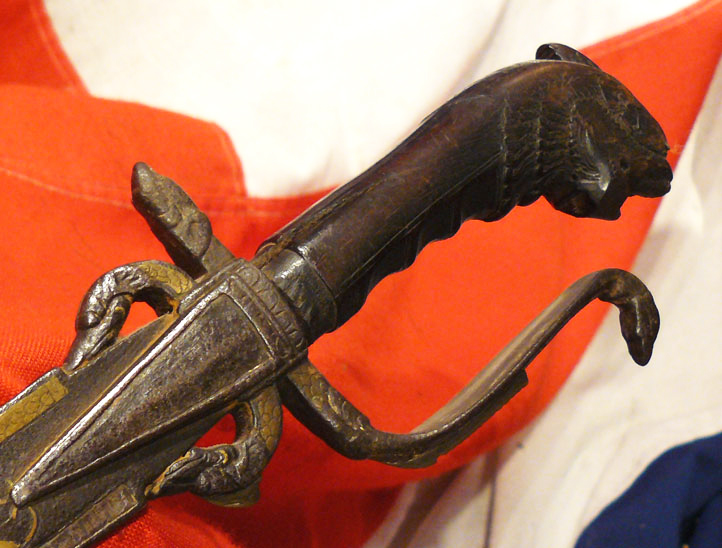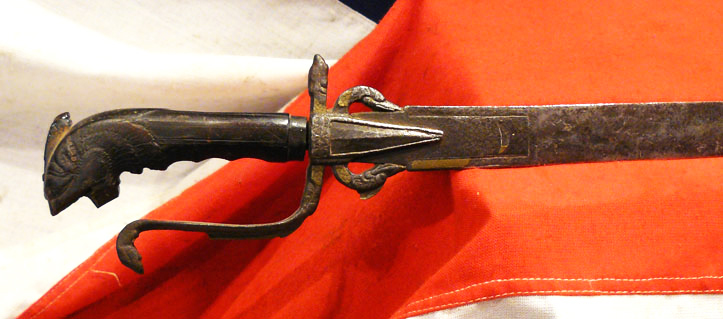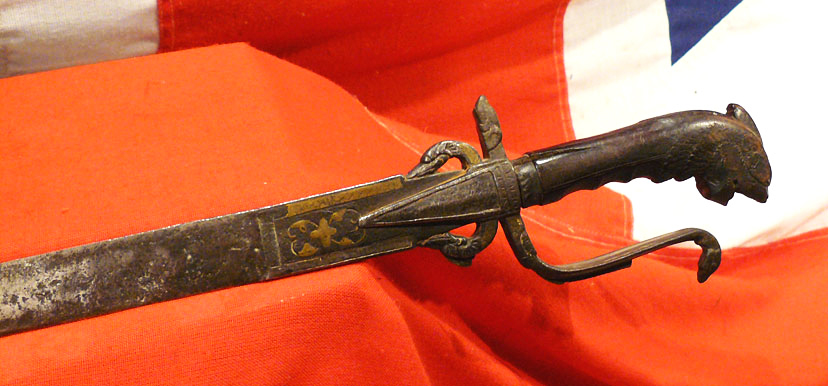A Most Rare Antique 17th Century Sinhalese Kastane Sword, Used as A Naval Officer's Hangar Acquired by the Early 17th Century Maritime Traders to Ceylon
A most interesting and fine kastane, with the carved wood “Simha” lion head pommel a recurved knuckleguard and two quillon also with a water beast, known as a Makara, head pommel and counter quillon with additional Makara
The hilt is delicately inlaid with brass inlays as is the blade. A typical 17th century sword from ancient Ceylon (now Sri Lanka) which was in ancient times known as the Kingdom of Lions (Sinhaladwipa) often termed Sinhala. The term Sinha is lion in Hindu. These lion-heads in grotesque form are of course representing this heritage. The makara represents the Hindu water beast (fish/crocodile) ridden by Varuna. Pommel with small jaw section lacking.The kastane is the national sword of Sri Lanka. It typically has a short curved single-edged blade, double-edged at the point. The hilt comprises a knuckle-guard and down-turned quillons, each terminating in a dragon's head. The swords were intended to serve as badges of rank; the quality of ornamentation depending on the status of the wearer.
The establishment of European trading contacts with South Asia by the late 16th and early 17th century led to these swords becoming fashionable dress accessories among European gentlemen and naval officer's of all hues, Be they Royal Naval, East India Co. Naval, or Privateers.
A kastane can be seen in an equestrian portrait of Colonel Alexander Popham at Littlecote House in the care of the Royal Armouries Collection (I.315). They were chosen by Naval officer's and indeed pirates, as their shape form and size was absolutely ideal for maritime close combat service.
Although also used on land, the cutlass is best known as the maritime weapon of choice. A naval side-arm, its popularity was likely because it was not only robust enough to hack through heavy ropes, canvas, and wood, but short enough to use in relatively close quarters, such as during boarding actions, in the rigging, or below decks. Another advantage to the cutlass was its simplicity of use. Employing it effectively required less technical skill than that required to master a rapier or light small sword, and it was more effective as a close-combat weapon than a full-sized sword would be on a cramped ship.
Cutlasses are famous for being used by pirates, and privateers although there is no reason to believe that Caribbean buccaneers invented them, as has occasionally been claimed. However, the subsequent use of cutlasses by pirates is well documented in contemporary sources, notably by the pirate crews of William Fly, William Kidd, and Stede Bonnet. French historian Alexandre Exquemelin reports the buccaneer François l'Ollonais using a cutlass/cuttoe as early as 1667. Pirates used these weapons for intimidation as much as for combat, often needing no more than to grip their hilts to induce a crew to surrender, or beating captives with the flat of the blade to force their compliance or responsiveness to interrogation.
Code: 21976
795.00 GBP





